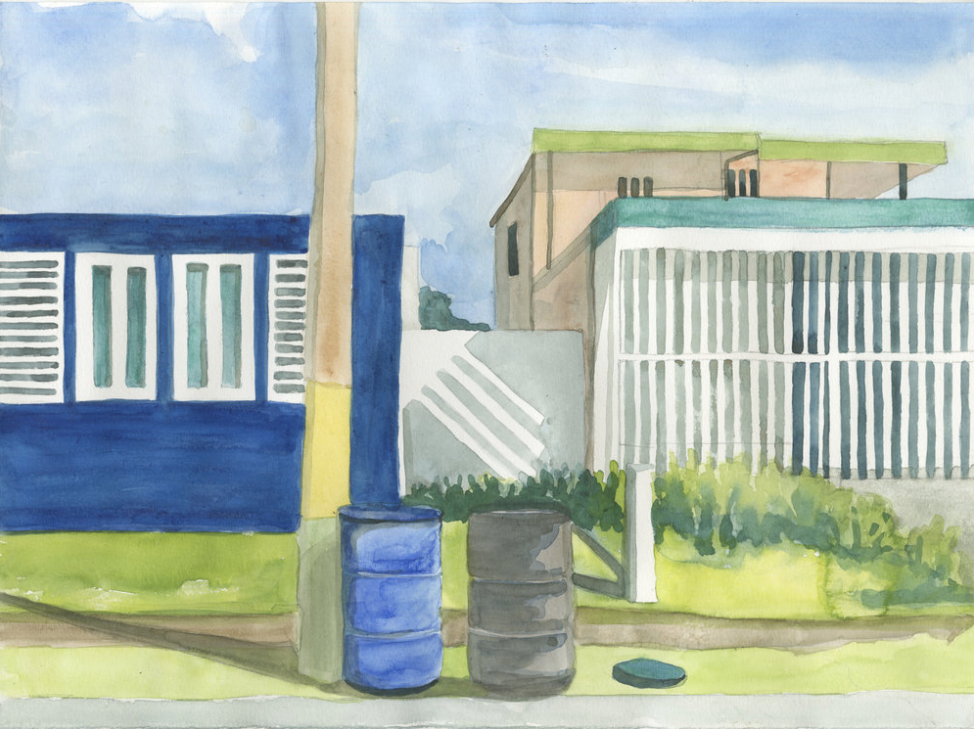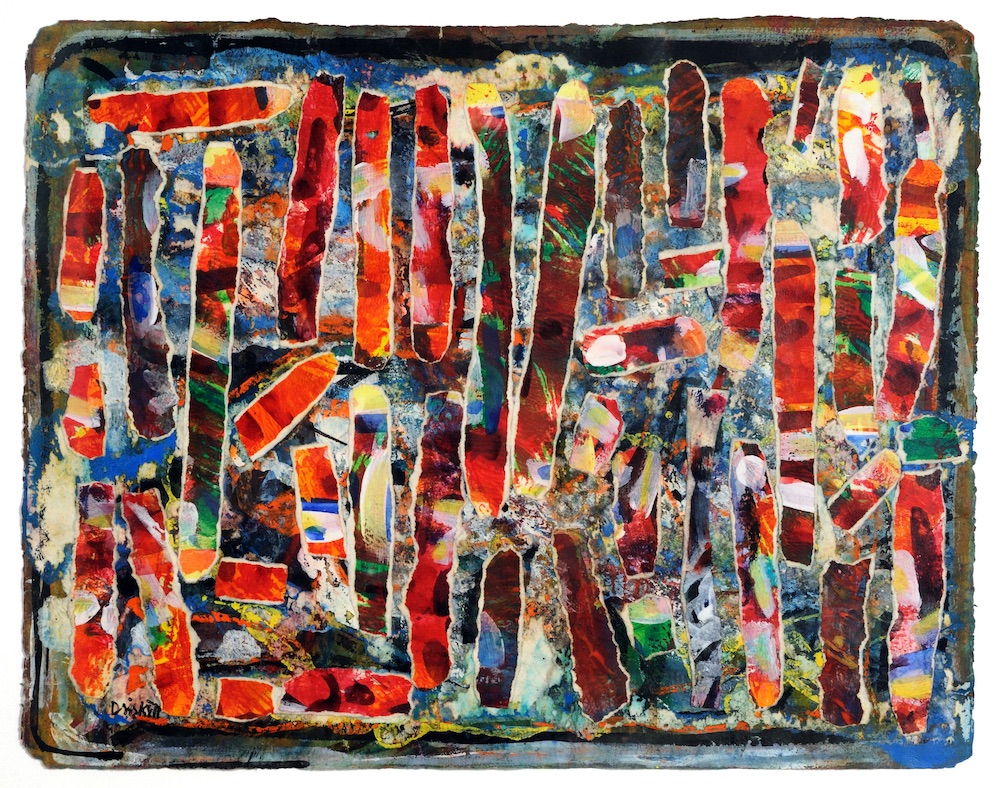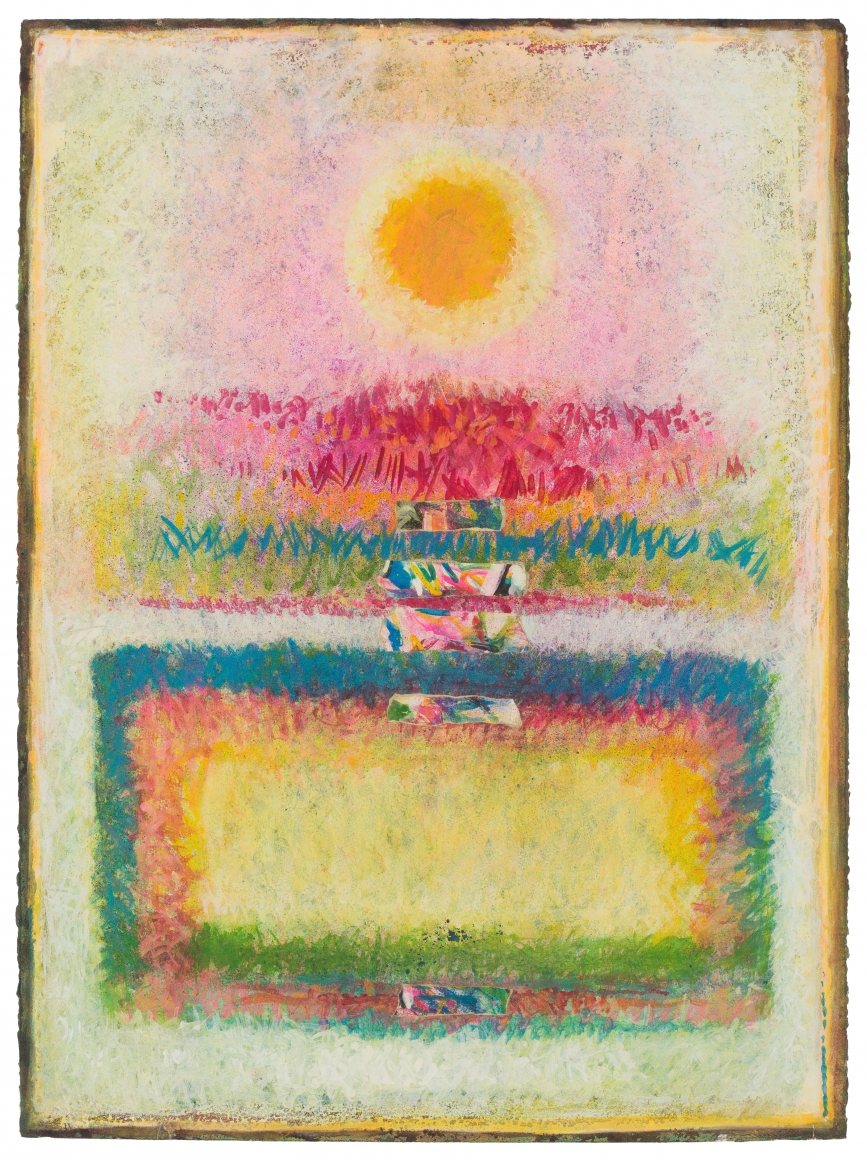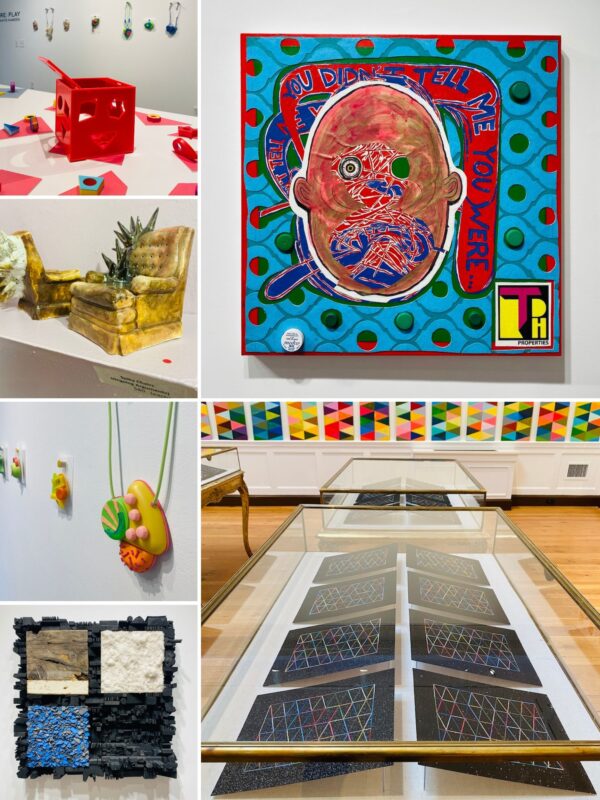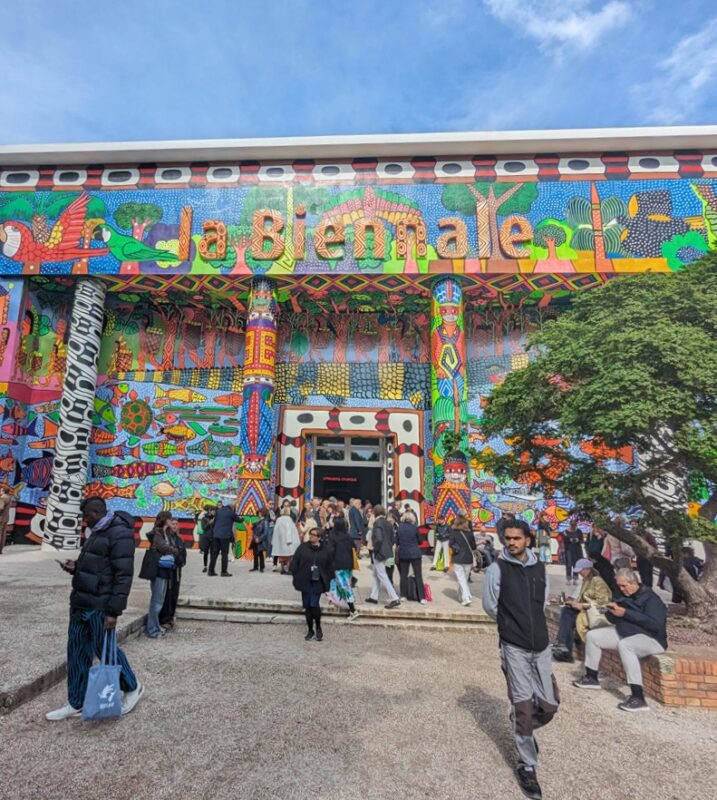David Driskell’s art practice cannot be defined by a singular style or art movement. Informed by myriad methodologies, his art demonstrates vibrant and expressive explorations in color, material, and form that elevate static scenes into distinct narratives about our tumultuous, magical, and mundane world. The work tends to be more conceptual than figurative, and when figures emerge, they are rendered as murky silhouettes, flat outlines, or faint geometric apparitions reminiscent of African masks.
Resonance: Paintings, 1965–2002, currently exhibited at the DC Moore Gallery in Chelsea, presents a selection of David Driskell’s works that were informed rather than restrained by the events that shaped a turbulent and reformative era: the assassination of major political leaders, the end of the Vietnam War, the evolution of a wounded but perseverant Civil Rights Movement, the liberation of African nations from colonial rule, and the beginning of American wars in the Middle East that persist into the contemporary moment.
 “Our Ancestors, Festival,” 1973, Oil on canvas, 50 x 50 inches
“Our Ancestors, Festival,” 1973, Oil on canvas, 50 x 50 inches
A scholar, historian, and former professor at the University of Maryland, College Park, Driskell says he hadn’t intended to become an art historian, but was motivated in part by his mentor, Professor James Porter at Howard University, to continue “pointing things out” and defining the field. “I wanted to add to what was there so that nobody could say that you can define American art without including people of color, women, and other so-called minorities,” Driskell says.
Through a lifelong experimentation with oils, acrylics, collage, and mixed media, Driskell has referenced the bright, gestural nuances of abstraction without being restricted by the genre. His incredible, 69-year-long career has been informed by an iconic roster of prolific artists, mentors, and peers such as Romare Bearden, Elizabeth Catlett, and members of the Washington Color School.
The works from the mid-1960s and into the late 1980s are most intriguing for their capture of the overarching energy of the times, reflecting the artist’s obsession with the challenges of art making—mainly, how do you capture a first impression, the energy of a moment, on a two-dimensional plane?
 David Driskell, “Ghetto Wall #2,” 1970, Oil, acrylic, and collage on linen, 60 x 50 inches
David Driskell, “Ghetto Wall #2,” 1970, Oil, acrylic, and collage on linen, 60 x 50 inches
In “Ghetto Wall #2” (1970), an image of a black figure and deconstructed red, blue, and white flag is positioned on a painted brick wall. The body of the figure, standing semi-center in the frame, is covered in the familiar symbols of nationhood: circles, stars, and stripes. The words “you,” “I,” “me,” “love,” as well as other illegible marks and scratches, are etched above the figure. Though the figure is included in the scene, the literal de-centering of their form, as well as the incorporation of other overwhelming shapes, create a compelling and clever commentary about American racial and economic inequities. Driskell challenges viewers to consider their own relationships to nationhood and patriotism, and how those ideologies are used to affirm or oppress citizens.
In other works, like “Memories of a Distant Past” (1975) or “Jazz Singer (Lady of Leisure, Fox)” (1974), Driskell presents figuration with the subtle incorporation of collage—an eye here, half of a face there, blended into gouache and tempera on paper. In every instance, the juxtaposition of humanoid forms with densely textured and color-laden environments shifts the focus away from the figure, bringing awareness to the ecstatic and meditative qualities of each environment.
This feature is especially prominent in Driskell’s works from the 1970s. During that time, the artist traveled throughout Africa to study the techniques of traditional artisans and was simultaneously invested in creating works that celebrated Black American cultural traditions. He felt it was his responsibility to make a statement through his art about his heritage, experiences, and connections to the diaspora—to reclaim his lineage.
“If I have a gift at all, it is to make straight the crooked, to put it together and make a statement that is convincing enough for people to say it makes sense because it relates to this and that, but is also timeless,” Driskell says. “It has to echo the larger element of who we are as human beings, who we hope to be, who we have been. That is a part of our historical ascendancy.”
 Installation view of Resonance, Paintings 1965–2002, at DC Moore
Installation view of Resonance, Paintings 1965–2002, at DC Moore
“The Ancient Watch” (1975), an acrylic and collaged work on canvas, is a wonderful example of the artist’s play with figuration, color, and form to evoke African diasporic imagery that transcends its two-dimensionality. A host of faces emerge from the center of a saturated environment, strokes of red, yellow, and blue, as well as small dots and symbols, are revealed through small gaps in an overlay of white gestural marks. By compounding layers of colored and white strokes, Driskell creates a luminous and otherworldly environment that immerses viewers in an indistinct world. Evocative of African masks, the faces are rendered with sharp, symmetrical lines and rounded brows that accentuate the ancients’ wide eyes and ever-present gaze.
Similarly, the oil painting “Our Ancestors, Festival” (1973), portrays another spirited example of the influence that African diasporic imagery has had on Driskell’s aesthetic. Bull and humanoid mask-like presences converge at the center of a blue circle that is divided by rectangular outlines and colorful dots that float and explode around the forms. Two black horns adorned with decorative designs sprout from the circle and out into an ornately patterned background. Bright orange, red, and yellow strokes rise like flames from the base of the frame and up through the circle. Here and in “The Ancient Watch,” Driskell engages African diasporic iconography as a celebratory endeavor, a resistant and radical proclamation that affirms and memorializes the histories and sacrifices of his ancestors. From Picasso to Mondrian, Monet to Cezanne, the influence of African artistry on the practices of so-called European masters is undeniable.
The exhibition also features a series of paintings that Driskell created in 1980 during an artist residency at Yaddo in Saratoga Springs, New York. These works employ color, form, and material to emphasize sunlight, reflection, and the illumination of real and imagined landscapes. In Mt. St. Helens’ Veil (1980), an egg tempera work on paper, an orange circular form reminiscent of a sun rests at the center of a blurred, vertically striated horizon that is blush with the warm tones of a summer sunset or sunrise. White smoke-like tendrils billow up from the edges and base of the frame, stretching beyond the horizon line and across the sun. The series evokes a meditative quality and Zen aesthetic that presents the natural world as sacred and mysterious.
Resonance presents an inspiring collection of rarely exhibited works. It is humbling to consider that Driskell sidetracked his own art practice so that he could develop a revisionist scholarship to help decolonize art history. The sacrifices of African American scholars and artists will never be fully acknowledged. Resonance is an intimate and timely acknowledgement of Driskell’s prolific career. At nearly 88 years old, Driskell remains a consummate collector of art, a scholar and lecturer, while also continuing to evaluate and evolve his own art practice. There is a testimony in that kind of sacrifice. So many of us have achieved our freedom, our sense of self and history, on the backs and at the hems of cultural innovators like Driskell, whose artistic success is magnified by his commitment to his community and the legacy of African American achievement.
The Beautiful Dust, 1980, Egg tempera on collage and paper, 30 x 22 inches; Summer Heat Mountain, 1980, Egg tempera on paper, 25 1/4 x 19 1/4 inches

Resonance, Paintings 1965-2002 is on view at DC Moore through June 8. For more information, visit the gallery’s website.
Top Image: Ancient Alphabets, 1990
Images courtesy DC Moore
